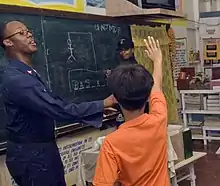Hangman (game)
Hangman is a paper and pencil guessing game for two or more players. One player thinks of a word, phrase or sentence and the other(s) tries to guess it by suggesting letters within a certain number of guesses.

History
Though the origins of the game are unknown, a variant is mentioned in a book of children's games assembled by Alice Gomme in 1894 called Birds, Beasts, and Fishes. In France the game is drawn with a man on a guillotine and the rest is drawn, minus a head of course.[1] This version lacks the image of a hanged man, instead relying on keeping score as to the number of attempts it took each player to fill in the blanks.
Overview
The word to guess is represented by a row of dashes, representing each letter of the word. In most variants, proper nouns, such as names, places, and brands, are not allowed. Slang words, sometimes referred to as informal or shortened words, are also not allowed. If the guessing player suggests a letter which occurs in the word, the other player writes it in all its correct positions. If the suggested letter does not occur in the word, the other player draws one element of a hanged man stick figure as a tally mark.
The player guessing the word may, at any time, attempt to guess the whole word. If the word is correct, the game is over and the guesser wins. Otherwise, the other player may choose to penalize the guesser by adding an element to the diagram. On the other hand, if the other player makes enough incorrect guesses to allow his opponent to complete the diagram, the game is also over, this time with the guesser losing. However, the guesser can also win by guessing all the letters that appear in the word, thereby completing the word, before the diagram is completed.
Variants

As the name of the game suggests, the diagram is designed to look like a hanging man. Although debates have arisen about the game,[2] it is still in use today. A common alternative for teachers is to draw an apple tree with ten apples, erasing or crossing out the apples as the guesses are used up.
The exact nature of the diagram differs; some players draw the gallows before play and draw parts of the man's body (traditionally the head, then the torso, then the arms and legs one by one). Some players begin with no diagram at all, and drawing the individual elements of the gallows as part of the game, effectively giving the guessing players more chances. The amount of detail on the man can also vary, affecting the number of chances. Some players include a face on the head, either all at once or one feature at a time. Some players include beheading the head as the last chance by drawing a line at the neck.
Some modifications to game play (house rules) to increase the difficulty level are sometimes implemented, such as limiting guesses on high-frequency consonants and vowels. Another alternative is to give the definition of the word; this can be used to facilitate the learning of a foreign language.
Strategy
The fact that the twelve most commonly occurring letters in the English language are e-t-a-o-i-n-s-h-r-d-l-u (from most to least), along with other letter-frequency lists, are used by the guessing player to increase the odds when it is their turn to guess. On the other hand, the same lists can be used by the puzzle setter to stump their opponent by choosing a word that deliberately avoids common letters (e.g. rhythm or zephyr) or one that contains rare letters (e.g. jazz).
Another common strategy is to guess vowels first, as English only has five vowels (a, e, i, o, and u, while y may sometimes, but rarely, be used as a vowel) and almost every word has at least one.
According to a 2010 study conducted by Jon McLoone for Wolfram Research, the most difficult words to guess include jazz, buzz, hajj, faff, fizz, fuzz and variations of these.[3]
Derivations
Brazil also had a show in the 1960s and again from 2012–2013 called Let’s Play Hangman, hosted by the legendary Silvio Santos. Brazil would later get its own version of Wheel of Fortune, running from 1980 to 1993, again from 2003 to 2012 (during which the new Let’s Play Hangman aired), and again since 2013 to the present. These shows were also hosted by Santos.
In July 2017, the BBC introduced a game show of its own called Letterbox, which is also based on Hangman.[4]
Example game
The following example game illustrates a player trying to guess the word hangman using a strategy based solely on letter frequency. As the player continues, a part of the stick figure on the noose is added. Once a full body is drawn, the game is over, and the player lost.
| 0 | 
| ||||||
| 1 | 
| ||||||
| 2 | 
| ||||||
| 3 | 
| ||||||
| 4 | 
| ||||||
| 5 | 
| ||||||
| 6 | 
| ||||||
| 7 | 
| ||||||
| 8 | 
| ||||||
| The guessing player has lost this game as the diagram had been completed before all the letters were guessed. | |||||||
References
- https://www.gutenberg.org/files/41727/41727-h/41727-h.htm#GameI_50
- Foreign English Teacher Under Attack For Playing Hangman Game] "Archived copy". Archived from the original on 2010-12-25. Retrieved 2011-03-11.CS1 maint: archived copy as title (link), Japan Probe, July 23, 2010
- McLoone, Jon (13 August 2010). "25 Best Hangman Words". Wolfram Research. Archived from the original on 15 August 2010. Retrieved 14 March 2015.
- http://www.ukgameshows.com/ukgs/Letterbox